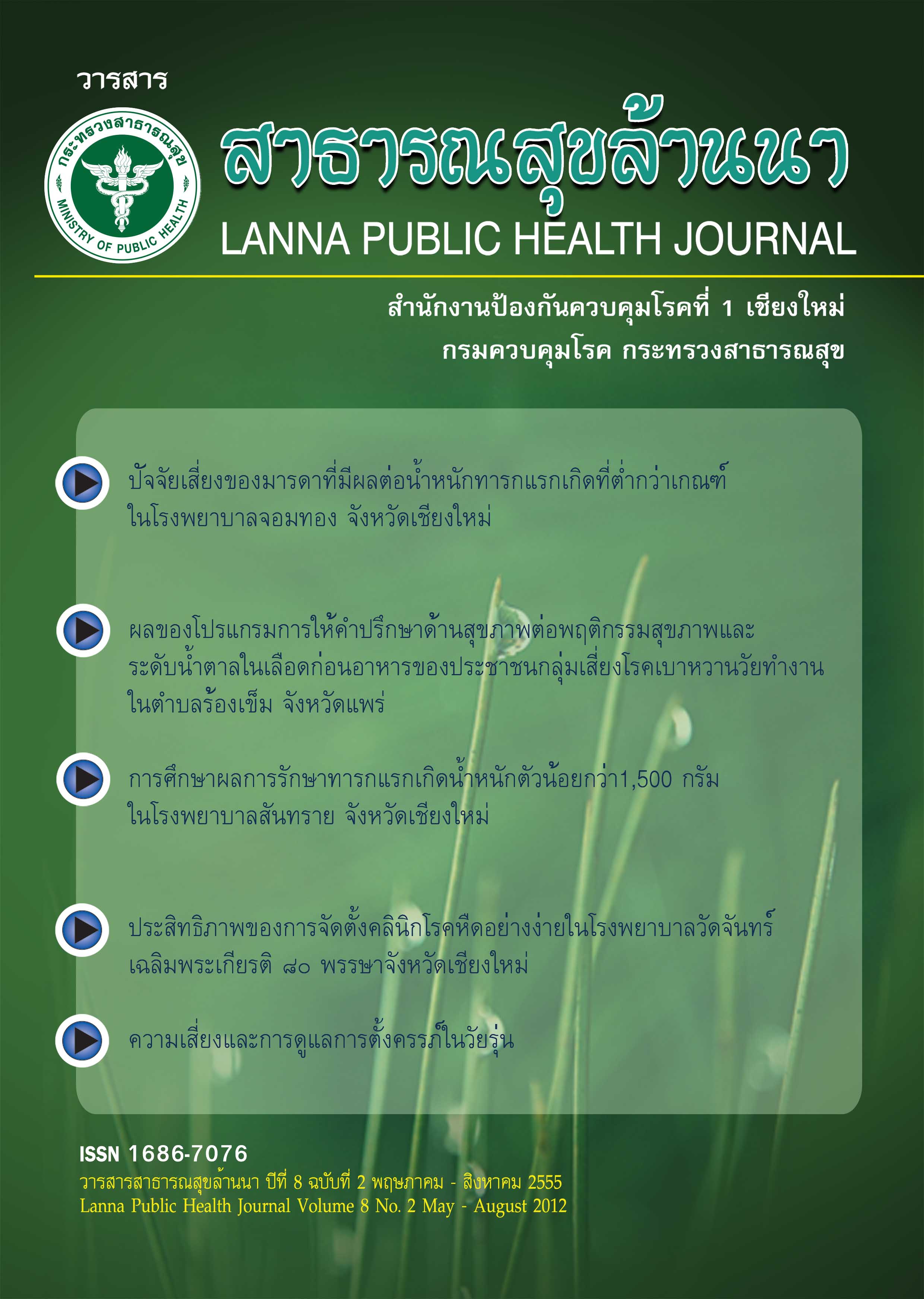การศึกษาผลการรักษาทารกแรกเกิดน้ำหนักตัวน้อยกว่า 1,500 กรัมในโรงพยาบาลสันทราย จังหวัดเชียงใหม่
คำสำคัญ:
ผลการรักษา, ทารกแรกเกิดน้ำหนักน้อยมากบทคัดย่อ
ทารกน้ำหนักน้อยมาก (<1,500 กรัม) เป็นกลุ่มที่มีอัตราการตายสูง ต้องใช้ทรัพยากรการดูแลมาก กลุ่มที่รอดชีวิตอาจมีภาวะแทรกซ้อนซึ่งมีผลต่อเนื่องต่อการเจริญเติบโตและพัฒนาการระยะยาว การศึกษานี้มีวัตถุประสงค์เพื่อศึกษาผลการรักษาทารกแรกเกิดน้ำหนักตัวน้อยมาก ปัจจัยที่เกี่ยวข้องกับการเสียชีวิตและการเกิดภาวะแทรกซ้อนของทารกแรกเกิดน้ำหนักตัวน้อยมากเป็นการศึกษาย้อนหลังโดยการเก็บข้อมูลจากเวชระเบียนของทารกแรกเกิดน้ำหนักตัวน้อยกว่า 1,500 กรัม ที่เข้ารับการรักษาในหอผู้ป่วยหนักทารกแรกเกิดโรงพยาบาลสันทรายตั้งแต่ 1 ตุลาคม 2551- 30 กันยายน 2554 โดยใช้สถิติเชิงพรรณนา วิเคราะห์ด้วยค่าแจกแจงความถี่ ร้อยละ ค่าเฉลี่ย และ chi-square
ผลการศึกษา พบว่า ทารกกลุ่มศึกษาจำนวน 65 คน เป็นเพศชายร้อยละ 52.3 เพศหญิงร้อยละ 47.7 น้ำหนักแรกเกิดเฉลี่ย 1206.8±202.03 กรัม อายุครรภ์ส่วนใหญ่อยู่ระหว่าง 28-31 สัปดาห์ มารดาที่อายุ ≤20 ปี 40% เป็นการตั้งครรภ์ท้องแรก 58.5% มีการฝากครรภ์ก่อนคลอด 60% มีมารดาเพียง 15.4% ที่ได้รับ Steroids ก่อนคลอด อัตราการรอดชีวิตในกลุ่มทารกน้ำหนักตัวน้อยมาก (VLBW) เท่ากับ 89% โดยอัตราการรอดชีวิตจะสูงขึ้นตามน้ำหนักตัวแรกเกิดที่มากขึ้น ปัจจัยที่มีผลต่ออัตราการตายของทารกอย่างมีนัยสำคัญทางสถิติ ได้แก่ ภาวะ Respiratory Distress Syndrome (RDS), น้ำหนักแรกเกิดที่ <1,000 กรัม, อายุครรภ์ที่ ≤ 28 สัปดาห์และการเกิดภาวะ Patent Ductus Arteriosus (PDA) มีผลต่ออัตราการตายของทารกเป็น 28.8, 9.6, 12.25 และ 4.2 เท่า ตามลำดับ
สรุป อัตราการรอดชีวิตและผลการรักษาของทารกน้ำหนักน้อยมาก ในการศึกษานี้ อยู่ในเกณฑ์ที่ยอมรับได้ อย่างไรก็ตาม การเพิ่มประสิทธิภาพในการดูแลรักษามารดาและทารกยังจำเป็นต้องมีการพัฒนาต่อไป
เอกสารอ้างอิง
เกรียงศักดิ์ จีระแพทย์. Breast feeding practice in premature infant. ใน: สุนทร ฮ้อเผ่าพันธุ์. Neonatology 2007. กรุงเทพ: บริษัท ธนาเพรส จำกัด, 2550: 12-23.
ดรุณี ศรีวิไล. การดูแลทารกแรกเกิดน้ำหนักน้อยมากที่โรงพยาบาลสมเด็จพระเจ้าตากสินมหาราช. พุทธชินราชเวชสาร 2548; 22(2): 146-154.
ดวงกมล เจริญเกษมวิทย์. อัตราการรอดชีวิตและปัจจัยเสี่ยงต่อการเสียชีวิตของทารกแรกเกิดน้ำหนักน้อยมากในโรงพยาบาลนครนายก. Thai Pharm Health Sci 2008; 3(1): 87-96.
ปนัดดา ลาภเจริญวงศ์, แสงแข ชำนาญกิจ, พรพัฒน์ รัศมีมารีย์ และปรียาพันธ์ แสงอรุณ. อัตราการตายและภาวะแทรกซ้อนของทารกน้ำหนักตัวน้อยและทารกคลอดก่อนกำหนด อายุน้อยกว่า 33 สัปดาห์ ในโรงพยาบาลพระมงกุฎเกล้า. เวชสารแพทย์ทหารบก 2545; 55: 205-210.
ปราโมทย์ ไพรสุวรรณา. Continous positive airway pressure (CPAP). ใน: สรายุทธ สุภาพรรณชาติ. Update neonatal care and workshop in neonatal care. กรุงเทพ: บริษัท ธนาเพลส จำกัด, 2545: 9-15.
รสสุคนธ์ เจริญสัตย์สิริ, สุภาภรณ์ สมหล่อ. การบริบาลทารกน้ำหนักน้อยมากที่โรงพยาบาลพระปกเกล้า จังหวัดจันทบุรีในช่วงสี่ปีของการเริ่มสหัสวรรษใหม่. วารสารศูนย์การศึกษาแพทย์ศาสตร์คลินิก โรงพยาบาลพระปกเกล้า 2547; 21: 175-183.
วรางทิพย์ คูวุฒิยากร. Care of the tiny baby: cardiovascular and respiratory management. ใน: วัฒนา ชาติอภิศักดิ์ และคณะ. What’s in What’s out in pediatrics. เชียงใหม่: คณะแพทยศาสตร์ มหาวิทยาลัยเชียงใหม่, 2552: 53-60.
สรายุทธ สุภาพรรณชาติ. Care of very low birth weight infant. ใน: สาธิต โหตระกิตย์. Neonatalcare in the year 2000: The prevention of morbilities. กรุงเทพ: บริษัท ธนาเพลส จำกัด, 2542: 30-3.
โสภาพรรณ เงินฉ่ำ. Nutritional management in preterm. ใน: สรายุทธ สุภาพรรณชาติ. Update neonatal care and workshop in neonatal care. กรุงเทพ: บริษัท ธนาเพลส จำกัด, 2545: 210-229.
Baradi E, Filipone M. Chronic lung disease after premature birth. N Engl J Med 2007; 257: 1946-55
Behrman RE, Stith Butler A. Complication of preterm birth. In: Behrman RE, Stith Butler A, eds. Preterm birth: cause, consequences and prevention. Washington DC: National Academies Press, 2007: 317-36.
Bregman J. Developmental outcome in very low birth weight infants. Current status and future trends. Pediatr Clin North Am 1998; 45:673-90.
Bryce J, Boschi-Pinto C, Shibuya K, et al. WHO estimates of the causes of death in children. Lancet 2005; 365: 1147-53.
Doyle LW, Kitchen WH, Ford GW, Richards AL, Kelly EA. Antenatal steroid therapy and 5-year outcome of extremely low birth weight infants. Obstet Gynecol 1989; 73: 743-746.
Dunn L, Hulman S, Weiner J, Kliegman R. Beneficial effects of early hypocaloric enteral feeding on neonatal gastrointestinal function: preliminary report of randomized trial.
J Pediatr 1988; 112(4): 622-629.
Evans NJ, Rutter N. development of the epidermis in the newborn. Biol Neonate 1986; 49: 74-80.
Fanaroff AA, Stoll BJ, Wright LL. Trends in neonatal morbidity and mortality for very low birth weight infants. Am J Obstet Gynecol 2007; 196(2): 147. e1-e8.
Hack M, Fanaroff AA, Outcomes of children of extremely low birth weight and gestational age in the 1990s. Semin Neonatal 2000; 5(2): 89-106.
Hintz SR, Poole WK, Wright LL, Fanaroff AA, Kendrick DE, et al. Changes in mortality and morbidities among infants born all less than 25 weeks during the post-surfactant era. NICHD Neonatal Research Network. Arch Dis Child Fetal Neonatal Ed 2005; 90: F128-33.
Lemons JA, Bauer C, Oh W. Very low birth weight outcomes of the National Institute of Child Health and Human Development Neonatal Research Network, January 1995 through December 1996. Pediatrics 2001; 107:E1.
Miksch R, Armbrust S, Pahnke J, Fusch C. Outcome of very low birth weight infants after introducing a new standard regimen with the early of nasal CPAP. Eur J Pediatric
2008; 167:909-916.
National Institute of Child Health and Human Development. Effect of corticosteroids for fetal maturation on perinatal outcome. NIH Consens Statement. 1994; 12(2): 1-24.
Roy KK, Batuah J, Kumar S, Malhotra N, Deorari AK and J.B. Sharme. Meternal antenatal profile and immediate neonatal outcome in VLBW and ELBW babies. J Pediatrics Indian 2006; 73: 669-673.
Saugstad OD. Oxygen and retinopathy of prematurity. J Perinatol; 2006; 26: Suppl 1:s46-50.
Sritipsukho S. Survival and outcome of very low birth weight infants born in a University Hospital with level 2 NICU. J Med Assoc Thai 2007; 90: 1323-1329.
Tapia JL. Very low birth weight infants outcomes in 11 South American NICU. J Perinatoloty 2002; 22: 2-7.
Thorngren-Jerneck K, Herbst A. Low 5-minute APGAR score: a population-base register study of 1 million term birth. Obstet Gynecol 2001; 98(1): 65-70.
Troche B, Harvey-Willkes K, Engle W, Nielsen H, Frantz I, 3rd , Mitchell M, et al. early minimal feeding promote growth in critically premature infants. Biol Neonate 1995; 67(3): 172-181.
Tsou KI, Tsao PN. The mortality and survival of very low birth weight infants in Taiwan. ActaPediatr Taiwan 2003; 44: 349-355.
Vanderveen DK, Mansfield TA, Eichenwald EC. Lower oxygen saturation alarm limits decrease the severity of retinopathy of prematurity. J AAPOS 2006; 10: 445-8.
Vohr BR, Wrihht LL, Dusuck AM. Center differences and outcomes of extremely low birth weight infants. Pediatrics 2004; 113: 781-9.








